Leadership Failures: An Analysis of the Enron Company's Downfall
VerifiedAdded on 2023/01/19
|8
|2110
|73
Report
AI Summary
This report provides a comprehensive analysis of the Enron Company, examining the leadership failures, ethical issues, and management strategies that contributed to its downfall. The report begins with an executive summary outlining the key areas of investigation, including ethical issues, strengt...
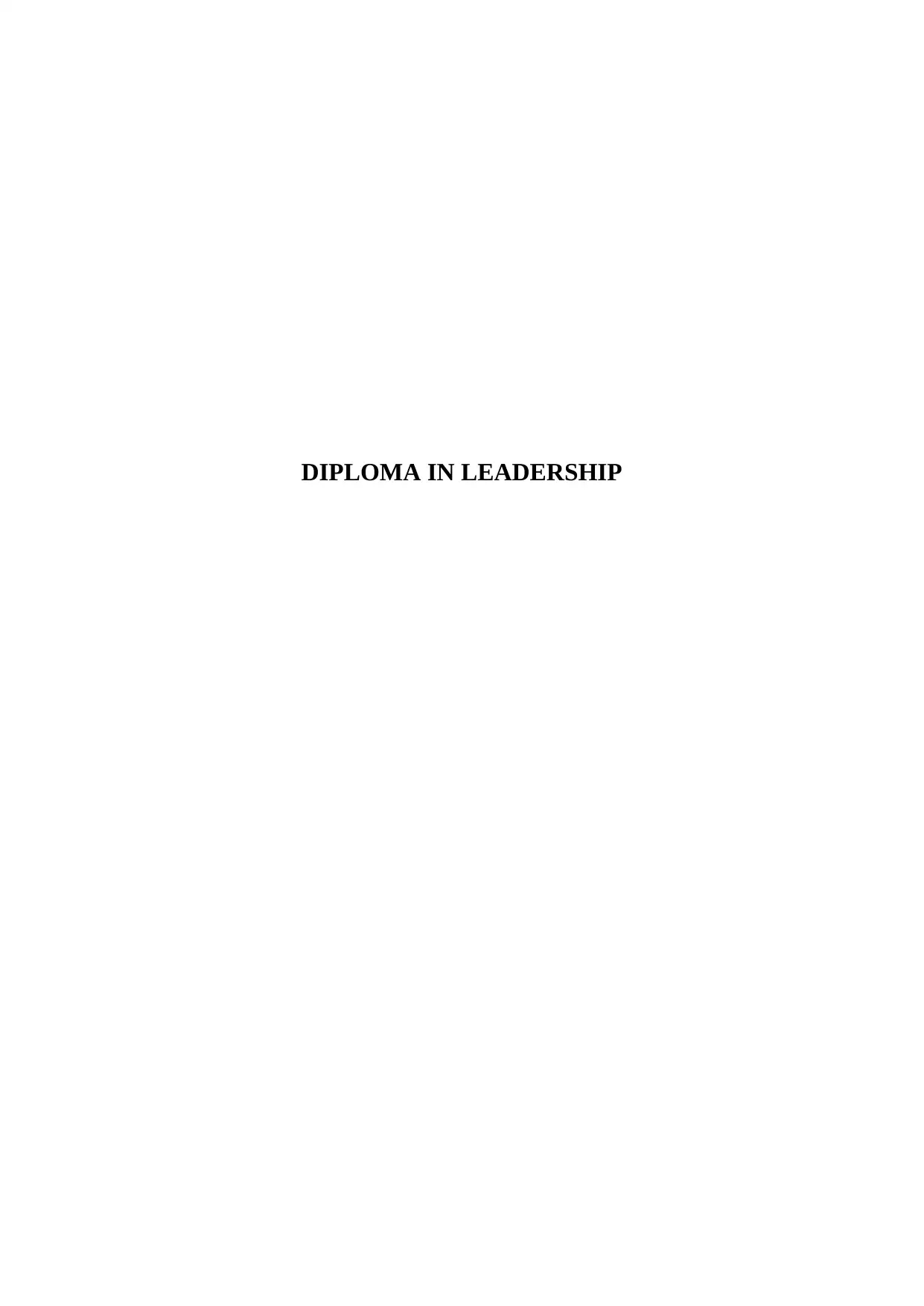
DIPLOMA IN LEADERSHIP
Paraphrase This Document
Need a fresh take? Get an instant paraphrase of this document with our AI Paraphraser
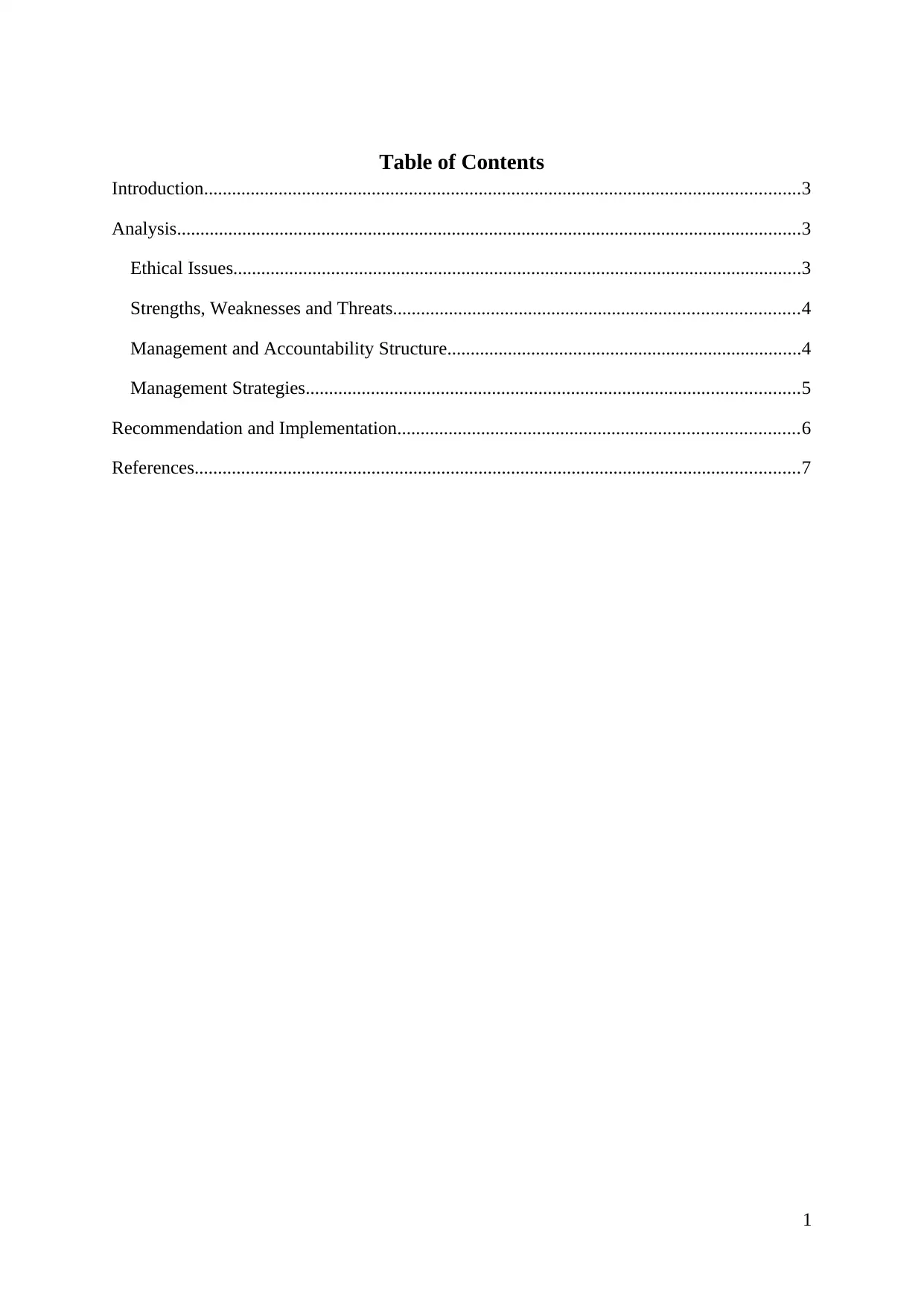
Table of Contents
Introduction................................................................................................................................3
Analysis......................................................................................................................................3
Ethical Issues..........................................................................................................................3
Strengths, Weaknesses and Threats.......................................................................................4
Management and Accountability Structure............................................................................4
Management Strategies..........................................................................................................5
Recommendation and Implementation......................................................................................6
References..................................................................................................................................7
1
Introduction................................................................................................................................3
Analysis......................................................................................................................................3
Ethical Issues..........................................................................................................................3
Strengths, Weaknesses and Threats.......................................................................................4
Management and Accountability Structure............................................................................4
Management Strategies..........................................................................................................5
Recommendation and Implementation......................................................................................6
References..................................................................................................................................7
1

Executive Summary
This paper aims to study the ethical issues, strengths, weaknesses, threats faced by the largest
natural gas provider the Enron Company. The paper will help to identify the ethical issues,
and act accordingly. The paper will show the reasons as to why the Company is currently
facing this situation. Detailed study of the strengths, weaknesses and threats along with the
current management flaws and recommendation and suggestion of new ideas and how to
implement them is concluded with simple and important guidelines. Proper management and
ethical business practice should be established in order to grow and develop as an
organization.
2
This paper aims to study the ethical issues, strengths, weaknesses, threats faced by the largest
natural gas provider the Enron Company. The paper will help to identify the ethical issues,
and act accordingly. The paper will show the reasons as to why the Company is currently
facing this situation. Detailed study of the strengths, weaknesses and threats along with the
current management flaws and recommendation and suggestion of new ideas and how to
implement them is concluded with simple and important guidelines. Proper management and
ethical business practice should be established in order to grow and develop as an
organization.
2
⊘ This is a preview!⊘
Do you want full access?
Subscribe today to unlock all pages.

Trusted by 1+ million students worldwide

Introduction
Leadership qualities are vital in running an organization. A good leader sets up the example
for the rest of the Company (Storey, 2016). In order to thoroughly understand the basics of
leadership, this paper aims to study the Enron Company and the events which led to the
downfall of the organization. Enron was the largest natural gas selling company in the United
States when it first started. It started sell natural gas at cheap discounts and began distributing
throughout the country. Soon, the Company began to shrink when internal ethical issues were
found and competitors started to follow and copy Enron’s innovative business approaches
(Epstein, 2018). Despite trying to hold its position in the market by expanding the business,
these investments failed to produce expected profits, the Company suffered heavy losses.
Analysis
Ethical Issues
The downfall of the biggest natural gas Company was led by a number of ethical issues.
These dishonest and unethical business practices led to mismanagement and soon the
Company was losing all of its stocks and analysts began to question the Company’s earnings
statements and accounting.
Competitive Rivalry
Enron was the largest natural gas selling Company in the United States. The Company had
introduced long-term contracts and future contracts to protect the buyers from any price
inflation. The Company was growing fast and made its mark in the market as the leader of the
brand. Soon, other companies were copying Enron’s business procedures and were
competing with the biggest natural gas provider (Jahromi, Fontes & Cochrane, 2017). The
competition in the market began to stiffen and Enron started to shrink in its profits. As other
Companies started to follow and copy the business standards of Enron, Enron lost its
competitive edge and was soon beginning to shrink as an organization.
Fraudulent Accounting
After several business expansion methods failed, Enron thought of hiring specialised
individuals who would help the Company present false statements which will help the
Company to maintain its reputation in the market (Bobek, Dalton, Daugherty, Hageman &
3
Leadership qualities are vital in running an organization. A good leader sets up the example
for the rest of the Company (Storey, 2016). In order to thoroughly understand the basics of
leadership, this paper aims to study the Enron Company and the events which led to the
downfall of the organization. Enron was the largest natural gas selling company in the United
States when it first started. It started sell natural gas at cheap discounts and began distributing
throughout the country. Soon, the Company began to shrink when internal ethical issues were
found and competitors started to follow and copy Enron’s innovative business approaches
(Epstein, 2018). Despite trying to hold its position in the market by expanding the business,
these investments failed to produce expected profits, the Company suffered heavy losses.
Analysis
Ethical Issues
The downfall of the biggest natural gas Company was led by a number of ethical issues.
These dishonest and unethical business practices led to mismanagement and soon the
Company was losing all of its stocks and analysts began to question the Company’s earnings
statements and accounting.
Competitive Rivalry
Enron was the largest natural gas selling Company in the United States. The Company had
introduced long-term contracts and future contracts to protect the buyers from any price
inflation. The Company was growing fast and made its mark in the market as the leader of the
brand. Soon, other companies were copying Enron’s business procedures and were
competing with the biggest natural gas provider (Jahromi, Fontes & Cochrane, 2017). The
competition in the market began to stiffen and Enron started to shrink in its profits. As other
Companies started to follow and copy the business standards of Enron, Enron lost its
competitive edge and was soon beginning to shrink as an organization.
Fraudulent Accounting
After several business expansion methods failed, Enron thought of hiring specialised
individuals who would help the Company present false statements which will help the
Company to maintain its reputation in the market (Bobek, Dalton, Daugherty, Hageman &
3
Paraphrase This Document
Need a fresh take? Get an instant paraphrase of this document with our AI Paraphraser
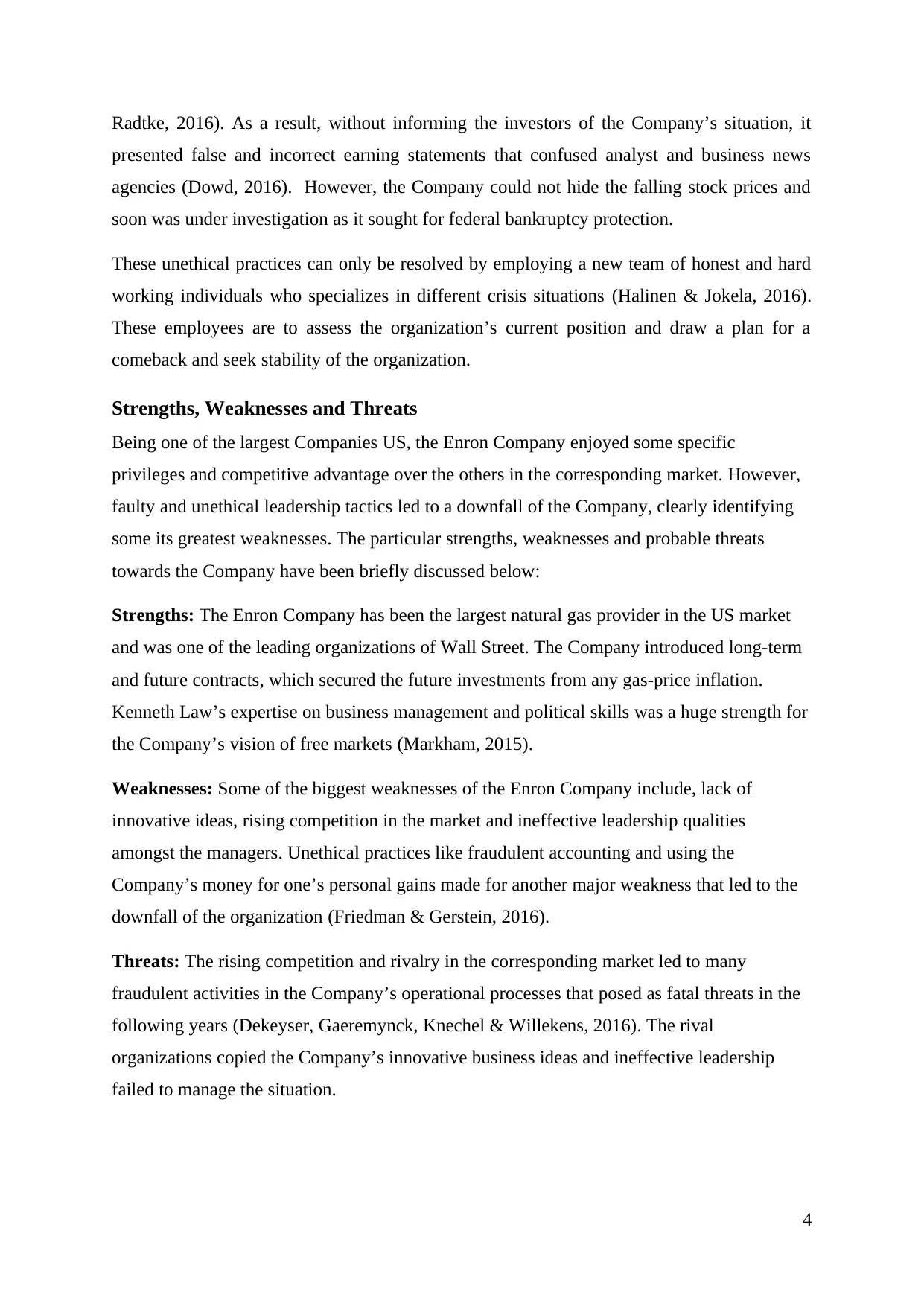
Radtke, 2016). As a result, without informing the investors of the Company’s situation, it
presented false and incorrect earning statements that confused analyst and business news
agencies (Dowd, 2016). However, the Company could not hide the falling stock prices and
soon was under investigation as it sought for federal bankruptcy protection.
These unethical practices can only be resolved by employing a new team of honest and hard
working individuals who specializes in different crisis situations (Halinen & Jokela, 2016).
These employees are to assess the organization’s current position and draw a plan for a
comeback and seek stability of the organization.
Strengths, Weaknesses and Threats
Being one of the largest Companies US, the Enron Company enjoyed some specific
privileges and competitive advantage over the others in the corresponding market. However,
faulty and unethical leadership tactics led to a downfall of the Company, clearly identifying
some its greatest weaknesses. The particular strengths, weaknesses and probable threats
towards the Company have been briefly discussed below:
Strengths: The Enron Company has been the largest natural gas provider in the US market
and was one of the leading organizations of Wall Street. The Company introduced long-term
and future contracts, which secured the future investments from any gas-price inflation.
Kenneth Law’s expertise on business management and political skills was a huge strength for
the Company’s vision of free markets (Markham, 2015).
Weaknesses: Some of the biggest weaknesses of the Enron Company include, lack of
innovative ideas, rising competition in the market and ineffective leadership qualities
amongst the managers. Unethical practices like fraudulent accounting and using the
Company’s money for one’s personal gains made for another major weakness that led to the
downfall of the organization (Friedman & Gerstein, 2016).
Threats: The rising competition and rivalry in the corresponding market led to many
fraudulent activities in the Company’s operational processes that posed as fatal threats in the
following years (Dekeyser, Gaeremynck, Knechel & Willekens, 2016). The rival
organizations copied the Company’s innovative business ideas and ineffective leadership
failed to manage the situation.
4
presented false and incorrect earning statements that confused analyst and business news
agencies (Dowd, 2016). However, the Company could not hide the falling stock prices and
soon was under investigation as it sought for federal bankruptcy protection.
These unethical practices can only be resolved by employing a new team of honest and hard
working individuals who specializes in different crisis situations (Halinen & Jokela, 2016).
These employees are to assess the organization’s current position and draw a plan for a
comeback and seek stability of the organization.
Strengths, Weaknesses and Threats
Being one of the largest Companies US, the Enron Company enjoyed some specific
privileges and competitive advantage over the others in the corresponding market. However,
faulty and unethical leadership tactics led to a downfall of the Company, clearly identifying
some its greatest weaknesses. The particular strengths, weaknesses and probable threats
towards the Company have been briefly discussed below:
Strengths: The Enron Company has been the largest natural gas provider in the US market
and was one of the leading organizations of Wall Street. The Company introduced long-term
and future contracts, which secured the future investments from any gas-price inflation.
Kenneth Law’s expertise on business management and political skills was a huge strength for
the Company’s vision of free markets (Markham, 2015).
Weaknesses: Some of the biggest weaknesses of the Enron Company include, lack of
innovative ideas, rising competition in the market and ineffective leadership qualities
amongst the managers. Unethical practices like fraudulent accounting and using the
Company’s money for one’s personal gains made for another major weakness that led to the
downfall of the organization (Friedman & Gerstein, 2016).
Threats: The rising competition and rivalry in the corresponding market led to many
fraudulent activities in the Company’s operational processes that posed as fatal threats in the
following years (Dekeyser, Gaeremynck, Knechel & Willekens, 2016). The rival
organizations copied the Company’s innovative business ideas and ineffective leadership
failed to manage the situation.
4
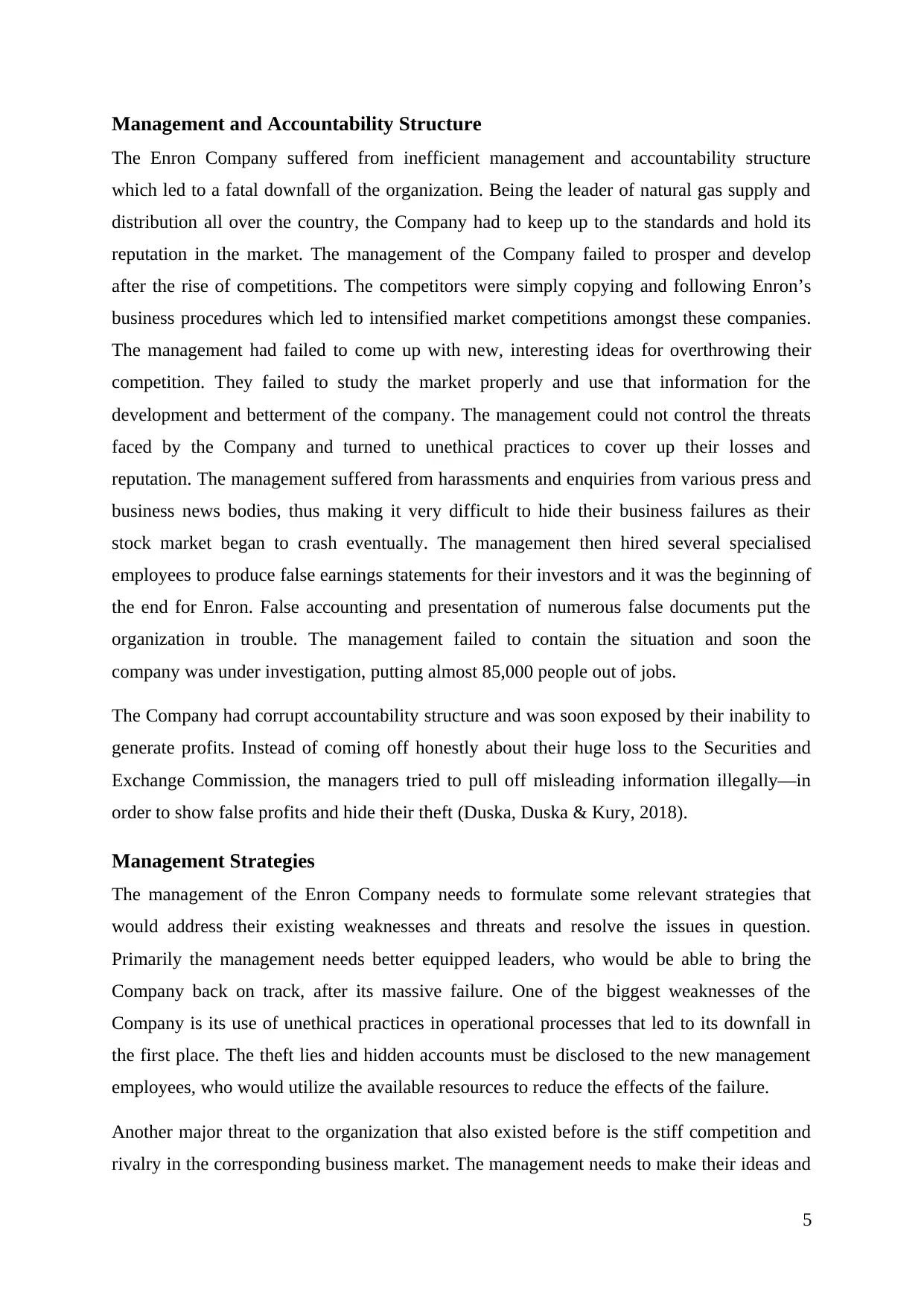
Management and Accountability Structure
The Enron Company suffered from inefficient management and accountability structure
which led to a fatal downfall of the organization. Being the leader of natural gas supply and
distribution all over the country, the Company had to keep up to the standards and hold its
reputation in the market. The management of the Company failed to prosper and develop
after the rise of competitions. The competitors were simply copying and following Enron’s
business procedures which led to intensified market competitions amongst these companies.
The management had failed to come up with new, interesting ideas for overthrowing their
competition. They failed to study the market properly and use that information for the
development and betterment of the company. The management could not control the threats
faced by the Company and turned to unethical practices to cover up their losses and
reputation. The management suffered from harassments and enquiries from various press and
business news bodies, thus making it very difficult to hide their business failures as their
stock market began to crash eventually. The management then hired several specialised
employees to produce false earnings statements for their investors and it was the beginning of
the end for Enron. False accounting and presentation of numerous false documents put the
organization in trouble. The management failed to contain the situation and soon the
company was under investigation, putting almost 85,000 people out of jobs.
The Company had corrupt accountability structure and was soon exposed by their inability to
generate profits. Instead of coming off honestly about their huge loss to the Securities and
Exchange Commission, the managers tried to pull off misleading information illegally—in
order to show false profits and hide their theft (Duska, Duska & Kury, 2018).
Management Strategies
The management of the Enron Company needs to formulate some relevant strategies that
would address their existing weaknesses and threats and resolve the issues in question.
Primarily the management needs better equipped leaders, who would be able to bring the
Company back on track, after its massive failure. One of the biggest weaknesses of the
Company is its use of unethical practices in operational processes that led to its downfall in
the first place. The theft lies and hidden accounts must be disclosed to the new management
employees, who would utilize the available resources to reduce the effects of the failure.
Another major threat to the organization that also existed before is the stiff competition and
rivalry in the corresponding business market. The management needs to make their ideas and
5
The Enron Company suffered from inefficient management and accountability structure
which led to a fatal downfall of the organization. Being the leader of natural gas supply and
distribution all over the country, the Company had to keep up to the standards and hold its
reputation in the market. The management of the Company failed to prosper and develop
after the rise of competitions. The competitors were simply copying and following Enron’s
business procedures which led to intensified market competitions amongst these companies.
The management had failed to come up with new, interesting ideas for overthrowing their
competition. They failed to study the market properly and use that information for the
development and betterment of the company. The management could not control the threats
faced by the Company and turned to unethical practices to cover up their losses and
reputation. The management suffered from harassments and enquiries from various press and
business news bodies, thus making it very difficult to hide their business failures as their
stock market began to crash eventually. The management then hired several specialised
employees to produce false earnings statements for their investors and it was the beginning of
the end for Enron. False accounting and presentation of numerous false documents put the
organization in trouble. The management failed to contain the situation and soon the
company was under investigation, putting almost 85,000 people out of jobs.
The Company had corrupt accountability structure and was soon exposed by their inability to
generate profits. Instead of coming off honestly about their huge loss to the Securities and
Exchange Commission, the managers tried to pull off misleading information illegally—in
order to show false profits and hide their theft (Duska, Duska & Kury, 2018).
Management Strategies
The management of the Enron Company needs to formulate some relevant strategies that
would address their existing weaknesses and threats and resolve the issues in question.
Primarily the management needs better equipped leaders, who would be able to bring the
Company back on track, after its massive failure. One of the biggest weaknesses of the
Company is its use of unethical practices in operational processes that led to its downfall in
the first place. The theft lies and hidden accounts must be disclosed to the new management
employees, who would utilize the available resources to reduce the effects of the failure.
Another major threat to the organization that also existed before is the stiff competition and
rivalry in the corresponding business market. The management needs to make their ideas and
5
⊘ This is a preview!⊘
Do you want full access?
Subscribe today to unlock all pages.

Trusted by 1+ million students worldwide

innovations more secure so that they are not stolen or copied by the rival organizations (Ojo,
2015). In order to gain competitive advantage over the rest of the organizations in the
industry, the Company needs to apply relevant marketing strategies with the help of efficient
employees and other stakeholders. The Company needs to dedicate itself to continuous
development processes in order to bring about a turnover in organizational sales profits. Strict
governance must be applied to ensure efficient utilization of available capital and resources
and avoid unethical practices like stealing or extortion.
Recommendation and Implementation
Unethical business practitioners should be removed from the organization as a first step to
development for Enron. New management guidelines need to be established with strict
follow-up procedures. A core team is to be assigned to supervise on all the transactions that
the company is undergoing and their job is to maintain the stability of the Company’s
financial conditions (Edwards, Hawkins & Schedlitzki, 2018). A ‘no-tolerance for corrupt
employees’ policy needs to be introduced which will denominate the chances of corruption in
the Company. Enron also needs to establish and rebuild their trust with their investors and
stakeholders. The management needs to employ more efficient employees who excel in their
interests, thus contributing to the development and prosperity of the company. Expert market
researchers and analysts should be hired when facing extreme competition and lack of new
innovative ideas.
To conclude, implementation of leadership qualities on the management group of the
Company would be beneficial as it is in grave need of a business turnover. Efficient
application of valuable decision-making is utmost important along with the practice of ethics
and responsibility.
6
2015). In order to gain competitive advantage over the rest of the organizations in the
industry, the Company needs to apply relevant marketing strategies with the help of efficient
employees and other stakeholders. The Company needs to dedicate itself to continuous
development processes in order to bring about a turnover in organizational sales profits. Strict
governance must be applied to ensure efficient utilization of available capital and resources
and avoid unethical practices like stealing or extortion.
Recommendation and Implementation
Unethical business practitioners should be removed from the organization as a first step to
development for Enron. New management guidelines need to be established with strict
follow-up procedures. A core team is to be assigned to supervise on all the transactions that
the company is undergoing and their job is to maintain the stability of the Company’s
financial conditions (Edwards, Hawkins & Schedlitzki, 2018). A ‘no-tolerance for corrupt
employees’ policy needs to be introduced which will denominate the chances of corruption in
the Company. Enron also needs to establish and rebuild their trust with their investors and
stakeholders. The management needs to employ more efficient employees who excel in their
interests, thus contributing to the development and prosperity of the company. Expert market
researchers and analysts should be hired when facing extreme competition and lack of new
innovative ideas.
To conclude, implementation of leadership qualities on the management group of the
Company would be beneficial as it is in grave need of a business turnover. Efficient
application of valuable decision-making is utmost important along with the practice of ethics
and responsibility.
6
Paraphrase This Document
Need a fresh take? Get an instant paraphrase of this document with our AI Paraphraser
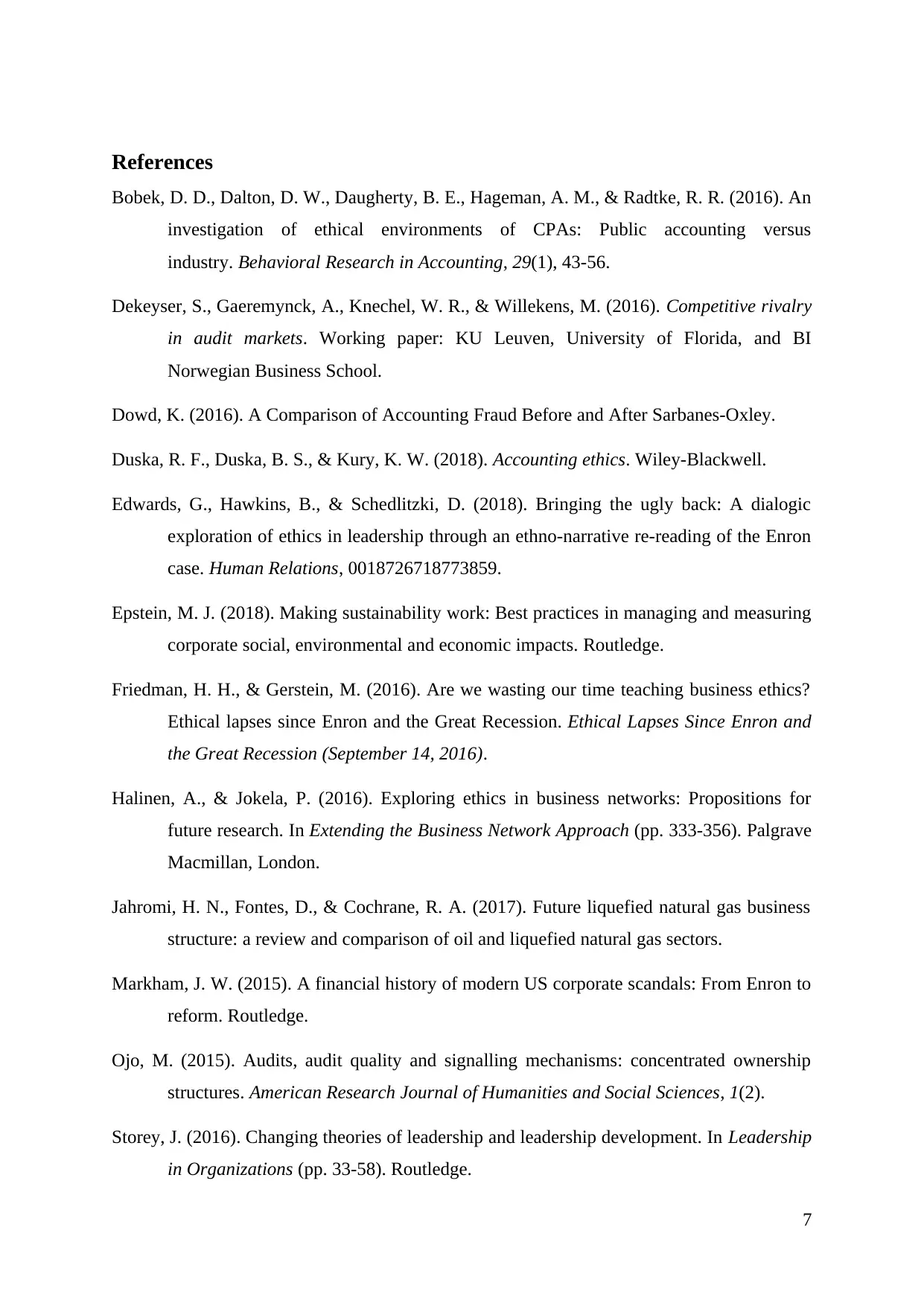
References
Bobek, D. D., Dalton, D. W., Daugherty, B. E., Hageman, A. M., & Radtke, R. R. (2016). An
investigation of ethical environments of CPAs: Public accounting versus
industry. Behavioral Research in Accounting, 29(1), 43-56.
Dekeyser, S., Gaeremynck, A., Knechel, W. R., & Willekens, M. (2016). Competitive rivalry
in audit markets. Working paper: KU Leuven, University of Florida, and BI
Norwegian Business School.
Dowd, K. (2016). A Comparison of Accounting Fraud Before and After Sarbanes-Oxley.
Duska, R. F., Duska, B. S., & Kury, K. W. (2018). Accounting ethics. Wiley-Blackwell.
Edwards, G., Hawkins, B., & Schedlitzki, D. (2018). Bringing the ugly back: A dialogic
exploration of ethics in leadership through an ethno-narrative re-reading of the Enron
case. Human Relations, 0018726718773859.
Epstein, M. J. (2018). Making sustainability work: Best practices in managing and measuring
corporate social, environmental and economic impacts. Routledge.
Friedman, H. H., & Gerstein, M. (2016). Are we wasting our time teaching business ethics?
Ethical lapses since Enron and the Great Recession. Ethical Lapses Since Enron and
the Great Recession (September 14, 2016).
Halinen, A., & Jokela, P. (2016). Exploring ethics in business networks: Propositions for
future research. In Extending the Business Network Approach (pp. 333-356). Palgrave
Macmillan, London.
Jahromi, H. N., Fontes, D., & Cochrane, R. A. (2017). Future liquefied natural gas business
structure: a review and comparison of oil and liquefied natural gas sectors.
Markham, J. W. (2015). A financial history of modern US corporate scandals: From Enron to
reform. Routledge.
Ojo, M. (2015). Audits, audit quality and signalling mechanisms: concentrated ownership
structures. American Research Journal of Humanities and Social Sciences, 1(2).
Storey, J. (2016). Changing theories of leadership and leadership development. In Leadership
in Organizations (pp. 33-58). Routledge.
7
Bobek, D. D., Dalton, D. W., Daugherty, B. E., Hageman, A. M., & Radtke, R. R. (2016). An
investigation of ethical environments of CPAs: Public accounting versus
industry. Behavioral Research in Accounting, 29(1), 43-56.
Dekeyser, S., Gaeremynck, A., Knechel, W. R., & Willekens, M. (2016). Competitive rivalry
in audit markets. Working paper: KU Leuven, University of Florida, and BI
Norwegian Business School.
Dowd, K. (2016). A Comparison of Accounting Fraud Before and After Sarbanes-Oxley.
Duska, R. F., Duska, B. S., & Kury, K. W. (2018). Accounting ethics. Wiley-Blackwell.
Edwards, G., Hawkins, B., & Schedlitzki, D. (2018). Bringing the ugly back: A dialogic
exploration of ethics in leadership through an ethno-narrative re-reading of the Enron
case. Human Relations, 0018726718773859.
Epstein, M. J. (2018). Making sustainability work: Best practices in managing and measuring
corporate social, environmental and economic impacts. Routledge.
Friedman, H. H., & Gerstein, M. (2016). Are we wasting our time teaching business ethics?
Ethical lapses since Enron and the Great Recession. Ethical Lapses Since Enron and
the Great Recession (September 14, 2016).
Halinen, A., & Jokela, P. (2016). Exploring ethics in business networks: Propositions for
future research. In Extending the Business Network Approach (pp. 333-356). Palgrave
Macmillan, London.
Jahromi, H. N., Fontes, D., & Cochrane, R. A. (2017). Future liquefied natural gas business
structure: a review and comparison of oil and liquefied natural gas sectors.
Markham, J. W. (2015). A financial history of modern US corporate scandals: From Enron to
reform. Routledge.
Ojo, M. (2015). Audits, audit quality and signalling mechanisms: concentrated ownership
structures. American Research Journal of Humanities and Social Sciences, 1(2).
Storey, J. (2016). Changing theories of leadership and leadership development. In Leadership
in Organizations (pp. 33-58). Routledge.
7
1 out of 8
Related Documents
Your All-in-One AI-Powered Toolkit for Academic Success.
+13062052269
info@desklib.com
Available 24*7 on WhatsApp / Email
![[object Object]](/_next/static/media/star-bottom.7253800d.svg)
Unlock your academic potential
© 2024 | Zucol Services PVT LTD | All rights reserved.





